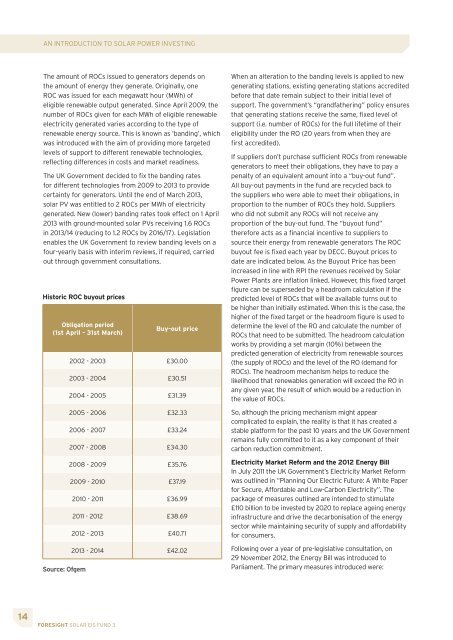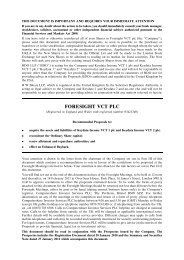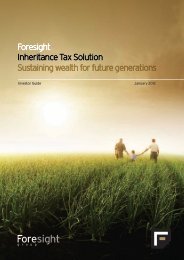Information Memorandum - Foresight Group
Information Memorandum - Foresight Group
Information Memorandum - Foresight Group
You also want an ePaper? Increase the reach of your titles
YUMPU automatically turns print PDFs into web optimized ePapers that Google loves.
AN INTRODUCTION TO SOLAR POWER INVESTING<br />
The amount of ROCs issued to generators depends on<br />
the amount of energy they generate. Originally, one<br />
ROC was issued for each megawatt hour (MWh) of<br />
eligible renewable output generated. Since April 2009, the<br />
number of ROCs given for each MWh of eligible renewable<br />
electricity generated varies according to the type of<br />
renewable energy source. This is known as ‘banding’, which<br />
was introduced with the aim of providing more targeted<br />
levels of support to different renewable technologies,<br />
reflecting differences in costs and market readiness.<br />
The UK Government decided to fix the banding rates<br />
for different technologies from 2009 to 2013 to provide<br />
certainty for generators. Until the end of March 2013,<br />
solar PV was entitled to 2 ROCs per MWh of electricity<br />
generated. New (lower) banding rates took effect on 1 April<br />
2013 with ground-mounted solar PVs receiving 1.6 ROCs<br />
in 2013/14 (reducing to 1.2 ROCs by 2016/17). Legislation<br />
enables the UK Government to review banding levels on a<br />
four-yearly basis with interim reviews, if required, carried<br />
out through government consultations.<br />
Historic ROC buyout prices<br />
Obligation period<br />
(1st April - 31st March)<br />
Source: Ofgem<br />
14 FORESIGHT SOLAR EIS FUND 3<br />
Buy-out price<br />
2002 - 2003 £30.00<br />
2003 - 2004 £30.51<br />
2004 - 2005 £31.39<br />
2005 - 2006 £32.33<br />
2006 - 2007 £33.24<br />
2007 - 2008 £34.30<br />
2008 - 2009 £35.76<br />
2009 - 2010 £37.19<br />
2010 - 2011 £36.99<br />
2011 - 2012 £38.69<br />
2012 - 2013 £40.71<br />
2013 - 2014 £42.02<br />
When an alteration to the banding levels is applied to new<br />
generating stations, existing generating stations accredited<br />
before that date remain subject to their initial level of<br />
support. The government’s “grandfathering” policy ensures<br />
that generating stations receive the same, fixed level of<br />
support (i.e. number of ROCs) for the full lifetime of their<br />
eligibility under the RO (20 years from when they are<br />
first accredited).<br />
If suppliers don’t purchase sufficient ROCs from renewable<br />
generators to meet their obligations, they have to pay a<br />
penalty of an equivalent amount into a “buy-out fund”.<br />
All buy-out payments in the fund are recycled back to<br />
the suppliers who were able to meet their obligations, in<br />
proportion to the number of ROCs they hold. Suppliers<br />
who did not submit any ROCs will not receive any<br />
proportion of the buy-out fund. The “buyout fund”<br />
therefore acts as a financial incentive to suppliers to<br />
source their energy from renewable generators The ROC<br />
buyout fee is fixed each year by DECC. Buyout prices to<br />
date are indicated below. As the Buyout Price has been<br />
increased in line with RPI the revenues received by Solar<br />
Power Plants are inflation linked. However, this fixed target<br />
figure can be superseded by a headroom calculation if the<br />
predicted level of ROCs that will be available turns out to<br />
be higher than initially estimated. When this is the case, the<br />
higher of the fixed target or the headroom figure is used to<br />
determine the level of the RO and calculate the number of<br />
ROCs that need to be submitted. The headroom calculation<br />
works by providing a set margin (10%) between the<br />
predicted generation of electricity from renewable sources<br />
(the supply of ROCs) and the level of the RO (demand for<br />
ROCs). The headroom mechanism helps to reduce the<br />
likelihood that renewables generation will exceed the RO in<br />
any given year, the result of which would be a reduction in<br />
the value of ROCs.<br />
So, although the pricing mechanism might appear<br />
complicated to explain, the reality is that it has created a<br />
stable platform for the past 10 years and the UK Government<br />
remains fully committed to it as a key component of their<br />
carbon reduction commitment.<br />
Electricity Market Reform and the 2012 Energy Bill<br />
In July 2011 the UK Government’s Electricity Market Reform<br />
was outlined in “Planning Our Electric Future: A White Paper<br />
for Secure, Affordable and Low-Carbon Electricity”. The<br />
package of measures outlined are intended to stimulate<br />
£110 billion to be invested by 2020 to replace ageing energy<br />
infrastructure and drive the decarbonisation of the energy<br />
sector while maintaining security of supply and affordability<br />
for consumers.<br />
Following over a year of pre-legislative consultation, on<br />
29 November 2012, the Energy Bill was introduced to<br />
Parliament. The primary measures introduced were:

















